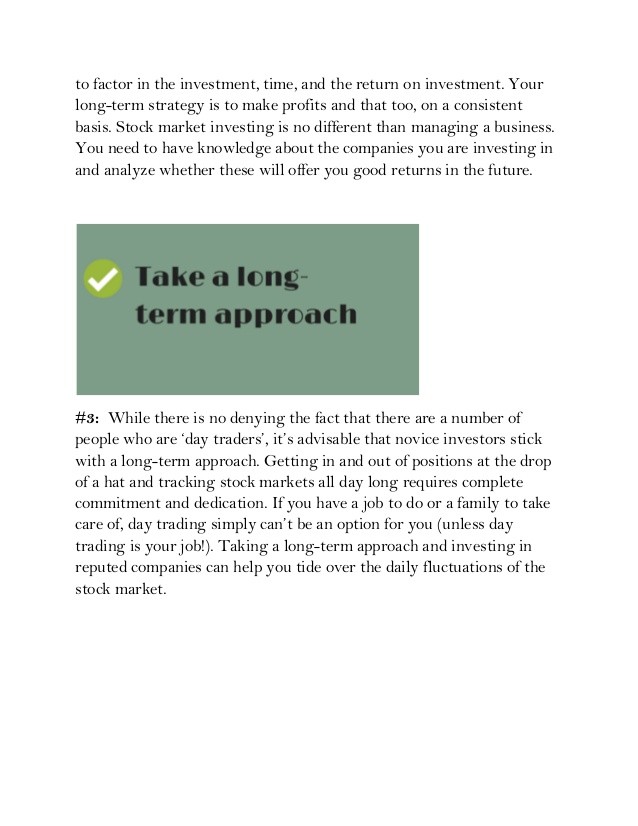Long Term Investing Tips and Strategies for Beginners
Post on: 28 Март, 2015 No Comment

Concerns about the volatility of the stock market, and the prospect of losses during downturn, have convinced many that stock investing is not for them. However, “safer” investments like cash and bonds may not provide the needed returns for your portfolio to overcome inflation. This is where it can help to understand the basic principles underlying long term investing.
What is Long Term Investing?
Long Term Investing is Big Picture
One of the most important aspects of long term investing is that it is big picture. You use long term investing as part of an overall financial plan that helps you reach your goals. Long term investing requires that you consider where you want to be in more than 10 years — and often what you want your finances to look like in 20 or 25 years.
Long term investing requires that you try and ignore the ups and downs of what is happening day-to-day on the financial market, and look at overall returns over time. With the stock market, this means reminding yourself that if you have enough time, the stock market will rebound. Over a 25-year period, the stock market has yet to come out behind.
Long Term Investing Requires a Certain Amount of Pickiness
Warren Buffett once advised that you not buy anything that you wouldn’t still want in 10 years. This means that you need to carefully consider your investments. If you are going to hold on to something for more than 10 years, you want it to have solid fundamentals.
In the case of individual stocks, this means that you should be looking at items such as capitalization, debt load, management competency, future prospects and earnings. You should not be making a decision based on yesterday’s share price if you want to choose long term investments that are likely to succeed. Do some research and make sure your investments, whether they involve individual stocks, bonds and currencies, or funds and trusts, are suited for riding out the down turns and providing a solid foundation for the future.
Long Term Investing is Usually Cost Efficient
Whether you tote up your costs due to taxes or to transaction fees, long term investing can be cost efficient. Long term capital gains taxes are lower than those you pay on short term gains. Anything you hold for longer than a year and a day will provide you with lower taxes. Additionally, vehicles like 401(k) and IRA retirement accounts are geared to be long term investments, and have their own tax advantages. You can also find tax advantages with ETFs and some other types of investments, such as municipal bonds (but be careful; these are riskier than U.S. Treasuries).

Less frequent trading is also an advantage of long term investing. When you make frequent trades, your earnings are eaten up through transaction charges. You can reduce your costs by trading less often.
Employing a long term investing strategy can also help you avoid the panic selling impulse that grips people during a down market. When you sell while the market is down, you are simply locking in your losses. Adhering to a long term strategy can help you remain focused on the big picture, and help you get more for your money as you buy stocks while they are “on sale.”
Long Term Investing Strategies
While there is nothing wrong with having some less risky investments in your long-term portfolio, it is important to remember that earning 3% to 5%, on average, from cash and bonds, will not be enough to give you the kind of growth you are looking for long term. Stocks need to be involved as part of your asset allocation in a successful long term investment portfolio. Here are some ideas that can work with a long term investing mindset:
- Index Funds. Because they follow indexes, index funds have no need for active management. This means fees are quite low, and your gains mirror the index as a whole, rather than relying on just one company. If you are invested in a fund that focuses on the S&P 500, you will gain over time as the index does. This is true of investments in foreign indexes, small cap indexes and even bond indexes.
- ETFs. Exchange traded funds allow a certain amount of diversity with low fees. You can also diversify across asset classes with funds that focus on commodities, bonds and currencies in addition to those that focus on stocks.
- Dividend Investing. If you are looking to get a regular payout, while increasing your portfolio, investing in companies that pay dividends can be a good move. It is also worth noting that many of the companies that offer solid dividends, or that offer regularly increasing dividends, are usually (but not always) fundamentally sound and make good long term investments. You can improve your portfolio growth by making use of a dividend reinvestment plan (DRIP) to buy more shares using what amounts to free money without paying transaction fees.
- Dollar-Cost Averaging. Investing a regular amount every month gets you in the habit of growing your portfolio, and keeps you investing when stocks are cheaper.
In the end, it is vital for you to work out what you want to accomplish with your money, and decide whether a long term investing strategy can work for you.














